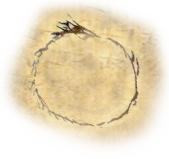Power Roll
Play Vocabulary (editing for clarity reqd.)
A characters' power roll is a dice roll made using a dice that represents a one-time effort, often basic physical bodily power biased towards brute strength (and implicit weight or mass), but which can also imply aptitude and developed ability in the general sense. In the simplest game, this dice is the base dice (ie. the standard dice used to play by all players and the Game Master and that is involved in every major dice roll, and that represents a particular effort and skill expressed by the character essaying some action).
The Power Role is often contrasted specifically against an Agility roll. The former being a roll centered on brute strength or body size (generally implying an essay requiring muscle or guts), and the latter being those rolls involving dexterity (that is, making use of the character's sinew statistic).
In a more advanced type of game (playable if a number of dice types are available), the power roll is a roll of the body dice, which plays the same role as the base dice (except for those activities biased instead towards agility, in which case an agility roll is used instead). A body dice (and thus base dice) and so too the agility dice (the dice used for agility rolls) varies for characters of different sizes and body structures: a medium-sized man or elf has a d6 body dice, while a large ogre has a d8 body dice. A halfling or gnome uses a d4 body dice, for example.
If your game is centered around a simple ruleset, then everyone will likely use a power roll for most dice rolls (ie using the base dice for the core mechanic), and this roll acts as a roll of the body dice (ie. physical effort manifested).
Simple games might use the standard square 6-sided dice exclusively, and in this case, all dice rolls use it, and it always acts as both 'power dice' and 'agility dice' for the power roll (which is simply the base dice roll, and is also an agility roll when the activity is keyed primary to sinew, such as an essay at tumbling or untying a knot). In this case, a character or creatures' relative dexterity due to body size needs to be modeled by offsets to the Sinew vital statistic at character creation.
If you have access to a more complete dice set (the standard platonic solids, the 'd20 set'), then a slightly more complicated game will use an inverted scale for actions involving agility or dexterity (ie. 'sinew'). In this case, a larger creature is usually less dextrous, and so an agility roll is used as the base roll instead of a power roll. A large troll with a d8 body dice will use a d6 agility dice, while a medium human with a d6 body dice uses a d8 agility dice. Whichever dice is in use, the result of the base roll is added to the relevant vital statistic result, which is itself either a constant bonus or penalty (ie. an offset), but (in yet another game type) can also be a dice roll using a dice of a certain kind, keyed to the characters' ability level in that area.
Action-- Jump: [dPower] + (d)Muscle [ + relevant bonuses ]
Action-- Dodge: [dAgility] + (d)Sinew [ + relevant bonuses ]
In the above, the dPower dice (used for physical strength-based activities, such as a jump) might always be a d6 dice, or it might represent the characters body dice (for example, a medium creature uses a d6 body dice, a large creature will use a d8 dice instead, and a small creature use a d4).
In the dodge example, within the simplest game, every dice roll is based on a d6, and thus the base roll is always a d6, be it an Power roll or Agility roll.
In a slightly more complex game, requiring multiple dice types, the Agility roll uses an inverted dice scale keyed to creature size (see Size And Scale).
In another kind of game, there is no separate 'base dice' at all, and all 'base rolls' make use of the relevant vital statistic, eg. an attempt to convince someone of something makes use of a dCharm roll as the base roll and the base dice in this case will be the characters Charm dice, be it a d4, d6, d10 or other.
See also:
